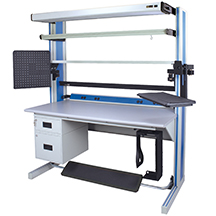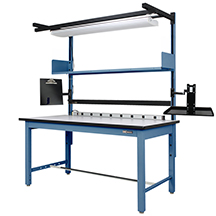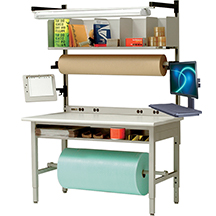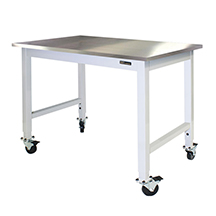How to Bring Ergonomics to the Factory Floor
By Joy M. Ebben, Ph.D, CPE
Human Factors and Ergonomic Specialist, IAC, a Division of Treston, Goodyear, Arizona
In my work as an ergonomist for a manufacturer of workstations, I deal with ergonomics as the human interface for assembling, testing, repairing and packaging electronic and mechanical components.
A safe interface is one of many design goals an ergonomist considers. In a typical manufacturing environment, a good ergonomist will be concerned not only with cumulative trauma disorders, but also with how well the manufactured product’s design supports fast and error-free assembly, particularly when undetected errors during final inspection could result in a catastrophic product failure.
If the product is to be installed in the field, the ergonomist may look at the larger system’s fault diagnostics, the ease with which defective parts can be removed and replaced, and how component failures are tracked. If the final product is to be used by people, the ergonomist may also address the product’s ease of use, taking into consideration the users’ age, language skills, perceptual and motor skills, and so on.
Assembly, Test And Repair
This effort is best begun during product design, usually as part of a concurrent engineering design approach. Companies should use an ergonomist trained in product design to work with the engineering group. The ergonomist’s role is to ensure that the product can be assembled, tested and repaired by the anticipated employee pool with some degree of training at an expected level of performance. The ergonomist usually performs a detailed task analysis of what the employees are expected to do and what errors they are likely to make. Design features should include:
- Accessibility of components.
- Data recording requirements.
- Decision-making requirements (i.e. pass/fail judgments during test).
- Different types of fasteners.
- Number and characteristics of tools.
- Sophistication and diagnostic capabilities of test procedures.
- Weight, size, shape, temperature and edge sharpness of components.
- Ease of component removal and replacement after assembly.
Musculoskeletal Disorder Risk Factors
There are at least six different types of musculoskeletal risk factors:
- Forceful exertions and motions.
- Extreme or repetitive exertions, postures and motions.
- Duration of exertions, postures, motions, vibration and cold.
- Insufficient rest or pauses.
- Work factors (for instance, close performance monitoring, wage incentives, machine-paced work).
- Environmental factors.
In workstation design, an important consideration in specifying workstations is the degree of flexibility required in height adjustment. Incorrect working height is often responsible for extreme postures and motions at the workstation. A distinction should be made between “working height” and “work surface height.” The two are almost always different. Consequently, the height of the work surface should be determined in relation to the height of the object being worked on and the task being performed.
Recommendations for the appropriate working height are defined in relation to the user’s elbow height. Here are some rules of thumb for working height:
- Six inches above elbow height for fine work such as proofing documents or inspecting small parts.
- Four inches above elbow height for precision work such as mechanical assembly.
- Same height as elbow for writing or light assembly,
- Four inches below elbow for coarse or medium work such as packaging.
General Recommendations
- Apply ergonomic design principals during product design.
- Conduct assembly error analysis to help anticipate where errors are likely and decide what to do about them.
- Analyze requirements for work surface size and shape, ajustability, storage, component management, and so on. Purchase accordingly.
- Analyze your requirements for workstation height adjustment. Remember that height adjustment includes the chair, footrest, work surface, fixtures and product. Prioritize where easy height adjustment should be provided. Consider purchasing workstations that are easily adustable.
- Spend thought and money on the workstation chair.
- Train and monitor employees regarding good work habits.
- Consider job enhancement to provide a range of physical movement and improve job interest.
One common question that reflects how often this concept is misunderstood is, “At what height should I put the worksurface?” the answer depends on several factors: the characteristics of the user, the height of the object being worked on, how much force is required to perform the task, and the adjustability of the chair and the footrest, personal preference and other details.
There are several ways to manipulate the height of the workpiece:
- Adjust the chair’s height.
- Adjust the work surface height by cutting off the workbench legs, putting blocks under the legs, or using adjustment capabilities provided by the workbench manufacturer.
- Adjust the height of the equipment, such as microscopes or magnifiers.
- Adjust the height of the workpiece using a fixture.
Keep in mind that many of these approaches require additional workstation modifications, such as arm or foot support.
Frequent Problems
Some of the more frequent ergonomic problems I see in “light-duty” manufacturing (including electronics) share one or more of these characteristics: poor product design, awkward postures, standing working positions at fixed-height workstations, poorly designed software, inadequate monitor maintenance, and chairs of inferior design.
Poor product design. Products are not designed for ease of assembly, test, repair or packaging with regard to the human in the loop. Too many companies have failed to define ergonomic goals for their products’ design, test, repair, or packaging. Regrettably, the human interface is addressed only after a problem has been identified.
It is far more cost-effective in the long run to apply ergonomics expertise during product design and to define human performance design goals for the employee pool, employee training, and tools. You can avoid many problems by developing guidelines for ergonomic design, training product and process designers to use them, and performing prototype assembly tasks before implementation.
Awkward postures. Awkward postures are prevalent in any work environment. Whether or not they create problems depends on a wide range of factors, including the degrees of awkwardness and the presence of other musculoskeletal risk factors.
One common posture at manual assembly workstations is a forward-bent neck during visual inspection. This often happens when people are using a magnifying “hoop” lens or a poorlydesigned microscope, and also when the visual task is too demanding for normal viewing distance but a magnifying system is not used. Solutions include:
- Providing a better-designed magnifying system that bends the image.
- Angling the item, not the hoop lens.
- Providing adjustable working height.
- Providing chairs with forward tilt.
- Training users to be aware of excessive neck bending.
Another awkward posture is raises shoulders. This is usually the result of a work surface set too high or a working height that is too high. For example, if the person is working on the top of a unit that is 12 inches high, he or she won’t be able to lower the work surface enough to put the working height at elbow height without interfering with leg clearance. This can also occur when the work surface is set too high to provide sufficient legroom for a center drawer or keyboard tray under the work surface. Solutions for raised shoulders include:
- Providing a worksurface and chair with a height range adjustment.
- Minimizing the height of fixtures.
- Providing a sit/stand workstation.
- Training users to be aware of raised shoulders and how to avoid the risk.
- Avoiding center drawers and undersurface keyboard trays.
Bent or rotated wrists and forearms are a third posture problem. These positions are often the result of inappropriate tool design (or lack of appropriate tools), poor access to components, and in appropriate operator techniques. Solutions include modifying how the ask is performed, providing properly designed tools, and training users to avoid awkward postures.
Users may be forced to repetitively reach behind their bodies when parts are stored on carts behind or adjacent to the assembler. Possible solutions are to put parts in front of the assembler, and sometimes to allow carts to be rolled under the work surface with access through the top of the work surface. If the carts are adjacent to the assembler, make them smaller so that all items are within acceptable reach.
People may develop poor upper body posture when they’re working with a unit that has a difficult size or orientation. A simple example is trying to insert a fastener into the back of a unit or into a chassis. Another primary reason for awkward upper body postures is computers with full-sized keyboards that are incorporated into assembly workstations. To help solve this problem, a company could provide rotating or tilting work surfaces to better orient the unit, design the unit so tasks don’t have to be performed from a wired range of positions, or provide sit/stand workstations.
Poor leg posture usually occurs when there is insufficient leg room or when an adjustable footrest is not provided. Examples include conveyor lines that people cannot fit their legs under, standing operations where there is no room for the employee’s toes, and center drawers or keyboard trays placed under a worksurface that is also used for manual assembly. Solutions include ensuring there is sufficient toe and leg clearance under the work surface and providing a footrest at fixed-height work surfaces.
Standing working positions. Standing working positions happen when people work at large equipment or at infrequently-used stand-alone computer workstations in manufacturing environments. Potential solutions are to provide a lift either underneath the equipment or for the employee, or to restrict the job to employees of a certain height.
Software and Monitors. The use of computers at manual assembly workstations is increasingly prevalent. However, many of the interfaces are not designed for ease of use. There is a wealth of information about the design of software/human interfaces, but it appears these guidelines are rarely applied in manufacturing settings. Also, many monitors in these environments produce degraded images because of dirt, age or general poor quality.
Potential solutions are to demand that industry software developers provide better human interfaces for their programs; to require internal software developers to seek the expertise of an ergonomics engineer and apply the principles of good human interface design; and to make sure that monitors are properly maintained and replace.
Chairs of inferior design. Poorly-designed chairs cause many ergonomic problems. Of all workstation items, the purchase of high-quality seating appears to meet with the most resistance at many companies. However, good seating improves safety and encourages proper posture. It’s a smart idea to identify appropriate chair features for the present and future, and then buy he best quality chair with these features.
 Buy Online Now!
Buy Online Now!
 Buy Online Now!
Buy Online Now!











